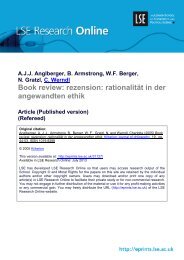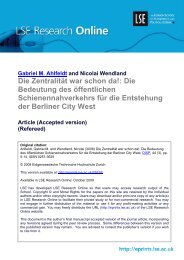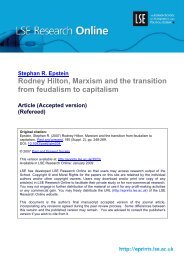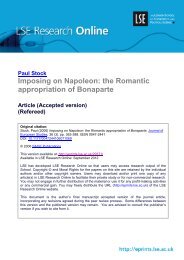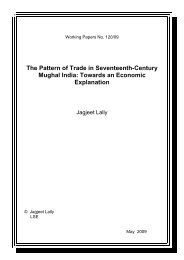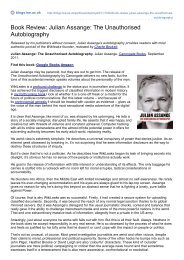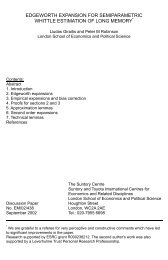Download (307Kb) - LSE Research Online
Download (307Kb) - LSE Research Online
Download (307Kb) - LSE Research Online
Create successful ePaper yourself
Turn your PDF publications into a flip-book with our unique Google optimized e-Paper software.
information were to grow, information resources must be perceived to be scarce. v<br />
When information society services, including audiovisual media services, are examined<br />
in this market oriented framework with its focus on scarce resources and the price<br />
system,<br />
there is no scope for a consideration of cultural issues of plurality or diversity.<br />
The information society vision took hold of the popular imagination in the 1990s and<br />
the political classes quickly picked up the message with Vice‐President Al Gore<br />
promoting the information highway in the United States and internationally and Martin<br />
Bangemann doing so in Europe (European Commission, 1994; Gore, 1993). Analytically,<br />
innovations in ICTs were associated with a change in ‘techno‐economic paradigm’<br />
resulting from the declining cost of storing, processing, communicating and<br />
disseminating information (Freeman and Soete, 1994). These changes in the role of<br />
ICTs would transform all sectors of the economy, and the audiovisual media services<br />
sector would not be an exception. The pressure would grow to ensure that policy would<br />
favour the operation of a competitive market in Europe for audiovisual media services,<br />
with increasingly less concern for the variety of purposes associated with the<br />
production<br />
of digital media content.<br />
Structural Transformation and Convergence<br />
A link between the structural composition and dynamics of this industry and its output<br />
has long been assumed to exist, even if there are disputes about whether media<br />
diversity and plurality can be achieved best as a result of market competition, through<br />
policy intervention, or a combination of both. McQuail (2005: 277), for example, states<br />
that market structure has important implications for ‘the type and amount of media<br />
content produced and offered to audiences’. The issue is whether, in a convergent ICT<br />
marketplace characterised by both ‘competition‐enhancing and competition‐reducing<br />
effects’ (Bauer, 2005: 80‐81), public interest goals are likely to be achieved. Studies in<br />
the political economy tradition, consistently posit a link, however indirect, between<br />
market structure and output based on empirical research addressing issues of labour,<br />
ownership,<br />
the mode of production, and regulation.<br />
The structure of media production is assumed to be intimately related to the<br />
consumption of symbolic content and the consequences for democratic participation in<br />
society (Garnham, 1990). Unlike the neoclassical framework in economics where<br />
existing distributions of power are assumed to be given or unalterable (Melody, 1994),<br />
6





